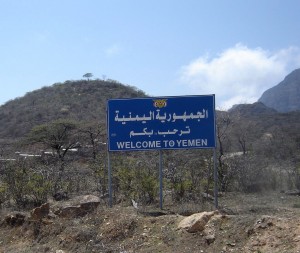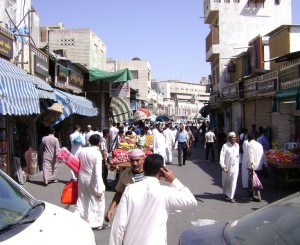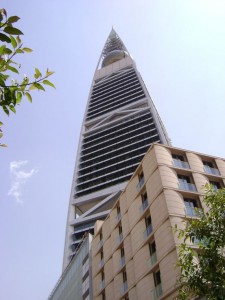Migrant workers and the Gulf states go together like bread and butter, but there are changes in the air. It started in the late 1980s with Omanization in Oman, which has been reasonably successful (in the public sector at least, the private sector is another matter); of late it has spread to other Gulf states, for even if policies aimed at reducing dependency on expatriate migrant labour have been in place for a long time very little has actually been achieved. In Saudi Arabia, for example, Saudization—the policy of replacing migrant workers with Saudi citizens—was first officially announced in 1994 but only recently has policy been put into practice. The aim, of course, is to encourage Saudi citizens, particularly the young, to work.
Although Saudi Arabia has the lowest percentage of migrant labourers in the workforce of all the Gulf states—officially just over 50% but probably somewhat higher in reality—the sheer numbers involved have far reaching implications, not only for Saudi Arabia itself, but for the region and for sending countries. The country has a population of 30 million, of whom 10 million are immigrants, and almost all of them are employed—it’s difficult to remain in the kingdom without a job and few immigrants are accompanied by their families. Official figures therefore cite eight million expatriate workers, to whom should be added a million or more irregular migrants, some of whom arrive on Umrah (pilgrimage) visas and overstay, others illegally cross the border from Yemen.
In Saudi Arabia, as in the other Gulf states, immigrant labour is managed through the kafala (sponsorship) system: immigrants must have a confirmed job before entering the country, and must work for their sponsor for the duration of their stay. Sponsorship (and a job) is a requirement for a residence permit (iqama). In theory, therefore, if the job ends the immigrant loses her sponsor, and consequently her iqama, and must return home. This is the theory. In practice there is a rampant black market aimed at circumventing the rules, selling “free visas”, and thousands of immigrants do not work for their sponsors. Although these loopholes in the system have led to exploitation, it is clear that a formal “blind eye” to such practices has also permitted immigrants to contribute positively to the Saudi economy.
Saudization
In 2011, the government got serious about Saudization and introduced the Nitaqat programme under which companies were classified as red, yellow, green or platinum according to the percentage of Saudi citizens in their workforce. At one extreme, red companies are prohibited from employing immigrants or renewing permits for those already employed, at the other, platinum companies can not only continue to employ foreigners but may poach employees from red companies at will.
The implementation of this system requires a systematic inventory of the workforce profiles of companies as they came under the scheme and, consequently, a regularisation of the status of those not working for their sponsors. Initially a deadline of April 4 was set for immigrants to regularise their status or leave the country without penalty, but it rapidly became clear that neither the government nor the various foreign consular services had the resources to meet this deadline. Lengthy queues of irregular migrants seeking passports, whether to leave or to obtain iqamas, became a permanent feature outside many consulates, and in some cases violence has broken out; as a result the amnesty period was extended to July 3. This also proved to be ambitious and the date has again been extended, to the end of the Islamic year in early November.
As an indication of the laxity surrounding the system (and the gap between discourse and reality) it is estimated that seven and a half million expats (that’s pretty much all of them) amended their status during the first four months of the amnesty period and more than one and a half million have changed their status entirely.
What does all this mean for the local labour market and for the immigrants themselves? The Saudi government has suggested that the crackdown could create up to 600,000 jobs for locals, which will go some way to alleviating the high levels of unemployment amongst a young population with a reputation for being idlers. However, for many immigrants, some of whom may have been in the country for decades—indeed, Saudi citizenship is so difficult to acquire many were born there and have no other home—and consider it their home, things are not so rosy. The ministry has reportedly been issuing 500 exit permits per day—a significant number; but estimates of actual numbers leaving vary wildly.
One Indian newspaper suggested that 27,000 Indian citizens would be leaving, only to publish a retraction the next day. The Saudi Gazette cited the passports authority as saying that 180,000 irregular migrants had left during the amnesty period, while the 
Yemeni government has asked the IOM for assistance as 200,000 migrants return from their northern neighbour. While these numbers are far from the 800,000 who returned to Yemen during the Gulf War crisis of the early 1990s, there are suggestions that more could return and they nevertheless represent a massive influx with which neither the Yemeni government nor the Yemeni economy is able to cope. To these should be added the tens of thousands of refugees and economic migrants currently in Yemen, mostly from Somalia and Ethiopia, and many of whom were intending to cross the border into Saudi in search of work. The new Saudi policies, increased border patrols and a new border fence, have made this almost impossible, thus placing increasing strain on Yemen as destitute migrants find themselves stranded in the border town of Haradh.
Are immigrants good or bad for the Saudi economy?
Immigration discourses in Saudi are much as they are elsewhere in the world: are immigrants good or bad for the economy, do they corrupt our culture or contribute to it? Are they all illegal, beggars or, worse, thieves, or do they do valuable jobs that Saudis are unwilling to do? The later proposition is perhaps the most realistic. Saudis will themselves admit that they have a reputation for being unwilling to work, and it’s generally recognised that many businesses have two managers, one, an expat, to run the company, the other, a Saudi, who is “in a meeting” when the inspectors arrive but will show up shortly. Saudis are unwilling to work for the low wages that expats receive, or run corner stores that stay open day and night for meagre profits. However, unemployment is high among Saudi citizens and many admit that there needs to be a cultural shift in attitudes towards work. Immigrants will not run the country forever, say some.
But radical and rapid shifts such as the one currently in progress have ripple effects elsewhere. Saudi Arabia is the world’s second remitting country, sending 26 billion dollars a year to families in homelands across Asia and elsewhere: the Saudization target of Saudi citizens making up 75% of the workforce would theoretically see four million expats—more than half of them—leave the country and, all other things being equal, a loss of an equal proportion of the remittances. This might be good for the Saudi economy but would have devastating effects elsewhere.
Similarly, migrants obliged to leave will want to go elsewhere, and many are already applying for visas to Canada (a perennial favourite) and the UK, and entering the US green card lottery scheme. And other social changes—and Saudi Arabia, under King Abdullah, more moderate than his predecessors, certainly seems to be changing— can also have an effect on migrants. Permitting women to drive, for example, would on the face of it, be an entirely positive move—but what about the 500,000 immigrant drivers who risk losing their jobs?
Saudi Arabia is the largest of the Gulf states, with a heterogeneity that the others lack, with their small populations and hydrocarbon-based economies: a large population, with both wealth and poverty, culturally diverse and geographically varied (with much scope for tourism) and a large agricultural sector—something that often comes as a surprise to those whose images of Saudi are of bedouin, camels and oil wells. But these are also difficult times for the kingdom. It is no longer isolated: facility of travel and, particularly, the internet, have brought foreign influences, for better or for worse. Economically the country is perhaps more dependent on its foreign partners that during the oil-boom years of the 1970s, and among them are the immigrants who have made the country what it is. Immigrants, particularly in Mecca and Jeddah, have long been part of Saudi life and their contributions to Saudi society have generally been beneficial. If the country is to continue to prosper, economically and socially, it is likely they will remain part of it for some time to come.

